6 Best Grass Types for Sacramento, CA
BY LAUREN BRYANT | MAY 25TH, 2023 | CALIFORNIA, LAWN CARE, SACRAMENTOSunny Sacramento is the perfect town for the outdoorsy type. You can enjoy its parks, rivers, and trails practically every day of the year. However, the dry, Mediterranean climate isn’t always friendly to lawns. Because of this, you need to choose a well-adapted grass type to give your turf the best chance.
The best grass types for Sacramento tolerate the summer heat and cool winters. Good news — you have lots of options. You can pick a grass based on drought hardiness, maintenance levels, color, shade tolerance, or foot traffic tolerance. No matter your priorities, one of these six grass types should meet your needs.
In this article, we’ll cover:
Warm-Season vs. Cool-Season Grasses
Turfgrass species are categorized based on their seasonal growth patterns and preferred climates. Warm-season grasses thrive in the southern U.S., while cool-season grasses do best in the northern U.S.
But where is that line drawn? Sacramento falls in the transition zone, which means both warm-season and cool-season grass types can survive. You must consider each category’s general characteristics to know which will work best for you.
Warm-Season Grass
- Summer is the peak growing season for these grasses. They grow best when temperatures are between 80 to 90 degrees Fahrenheit.
- The bulk of lawn care needs to be done in spring and summer.
- Warm-season grasses will go dormant and turn brown when air and soil temperatures drop below 50 to 55 degrees Fahrenheit.
- They tend to be more drought-tolerant and less cold-tolerant.
- The best time to plant warm-season grasses is in late spring or early summer.
Cool-Season Grass
- Spring and fall are the peak growing seasons for these grasses when temperatures are between 60 and 75 degrees Fahrenheit.
- The bulk of lawn care needs to be done in spring and fall.
- Cool-season grasses may go dormant and turn brown when temperatures are consistently below freezing or during hot, dry summers.
- They tend to be more cold-tolerant and less drought-tolerant.
- The best time to plant cool-season grasses is in fall or spring.
6 Warm-Season and Cool-Season Grasses for Sacramento
1. Bermudagrass
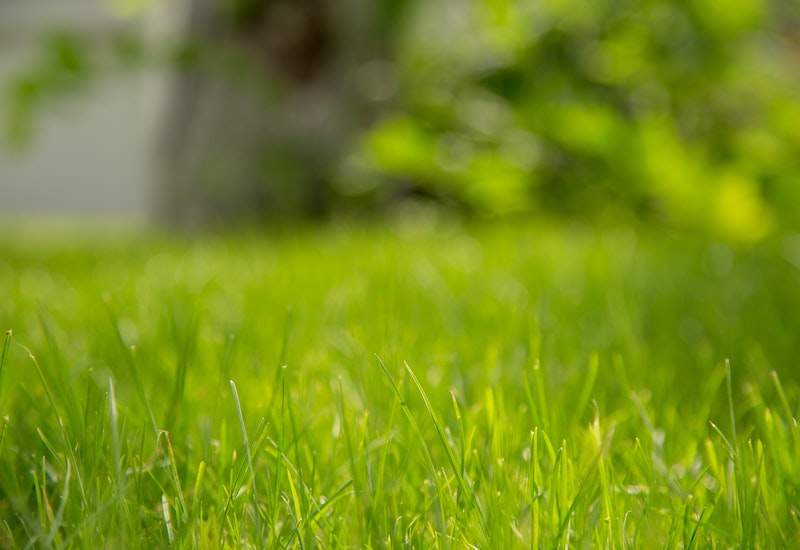
Photo Credit: Pexels
With a gray-green color and a medium to coarse texture, Bermudagrass is well-adapted to California’s climate. It loves full sun and high temperatures and holds up well during drought. Bermudagrass bounces back quite well from foot traffic and diseases while actively growing. It also has a good salt tolerance — despite not being directly next to the ocean, some parts of the Central Valley do deal with salinity issues.
Bermudagrass is quick-growing, so it needs frequent mowing. While this aggressive growth can help it outcompete weeds, it could spread into your garden bed or any viable ground nearby. Homeowners interested in this variety should edge their lawns with rocks, gravel, bricks, or plastic to prevent unwanted spread.
Though this grass type loves the heat, it doesn’t do well with cold temperatures or shade. It may turn brown in the winter as Sacramento temperatures drop into the 50s and 40s. Bermudagrass lawns also will be more susceptible to traffic damage during this time.
Classification: Warm-season grass
Spreads by: Stolons and rhizomes
Shade tolerance: Poor — needs full sun
Drought tolerance: High
Foot traffic tolerance: High
Maintenance needs: Needs frequent mowing due to fast growth
Recommended mowing height: 1-2 inches
Potential for disease: Good disease resistance, although diseases are common; low resistance to insects; keep an eye out for problems like Bermudagrass mites, dichondra flea beetles, fiery skippers, and spring dead spot.
Soil pH: 6-6.5
Soil type: Tolerates most soil types
Other notes: Bermuda spreads aggressively via its stolons (above-ground stems) and rhizomes (below-ground stems) and can out-compete many weeds. The downside is that it also can be a nuisance and is sometimes considered invasive. You’ll often find it has tunneled underground into flower beds and spread into neighboring lawns. It has a decent salt tolerance.
2. Buffalograss
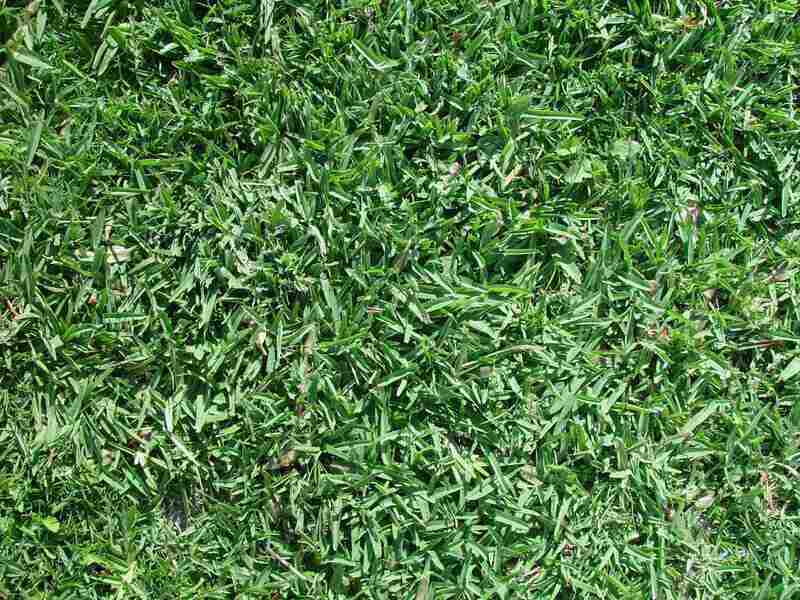
Photo Credit: Pixnio
This fine-textured, grayish-green grass is best known for gracing the central plains. However, UC Davis and UC Riverside researchers developed a California cultivar called UC Verde buffalograss. This cultivar is especially drought and heat tolerant.
Buffalograss is low-maintenance with little water, fertilizer, and mowing needed. These qualities make it suitable for busy homeowners or those less passionate about lawn care. Though drought resistant, it may turn brown if not watered in the summer. Not to worry, though — it will recover well from drought once it has something to drink.
One unappealing quality of buffalograss is its long winter dormancy. Though most cultivars survive cold weather, they will be brown all winter. It also doesn’t tolerate shade well. The seeds and sod can be expensive compared to other grass types.
Classification: Warm-season grass
Spreads by: Stolons
Shade tolerance: Very low — best suited for full sun
Drought tolerance: High
Foot traffic tolerance: Very low, but light use or rare heavy use is OK
Maintenance needs: Low mowing frequency — once per week or less
Recommended mowing height: 2-4 inches or leave unmowed; UC Verde doesn’t grow taller than 4-6 inches
Potential for disease: Good tolerance against diseases and insects
Soil pH: 6.5-7.5
Soil type: Prefers soils that aren’t sandy
Other notes: Buffalograss often turns brown in winter. Because of its few flowerheads, it produces little pollen and seeds, making it suitable for those with allergies.
3. St. Augustinegrass
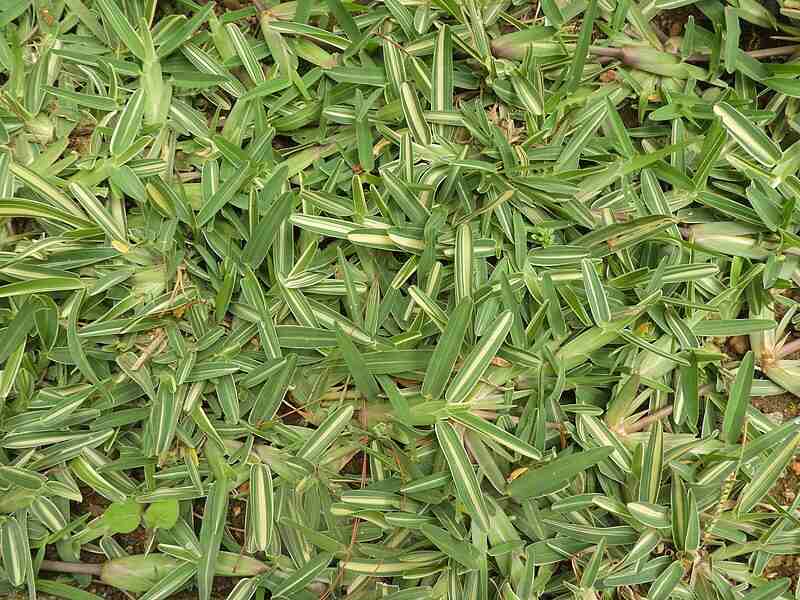
St. Augustinegrass
Photo Credit: Yercaud-elango / Wikimedia Commons / CC BY-SA 4.0
St. Augustinegrass has a medium green color and broad leaf blades. It’s salt tolerant, water-efficient, and has few pest problems. Though it prefers full sun, it tolerates shade better than most warm-season grasses. St. Augustinegrass does well in general lawns but doesn’t handle high foot traffic well — that means no backyard sports games if you want to keep it healthy.
This grass’ dense growth pattern helps it outcompete weeds. However, it does produce a lot of thatch (a buildup of plant debris above the soil) that could make it difficult to mow. Dethatch your lawn in late spring if the thatch depth exceeds ½ inch. It’s also crucial to keep up with mowing. If you try to cut off more than ⅓ of the height in a single mow, the grass will suffer from scalping damage.
St. Augustinegrass has poor cold tolerance, with an active growth period between March and October. Its growth will slow down in spring and fall, going dormant in late autumn. There are no commercially available seeds for this grass type, so you must establish with sod or bushels of stolons.
Classification: Warm-season grass
Spreads by: Stolons
Shade tolerance: Moderate shade tolerance, among the highest of any warm-season grass; some cultivars are more shade tolerant than others
Drought tolerance: Moderate
Foot traffic tolerance: Moderate
Maintenance needs: Moderate to high mowing frequency
Recommended mowing height: 2.5-4 inches (mow dwarf varieties from 2.5-3 inches; standard cultivars from 3-4 inches; mow tall in the shade)
Potential for disease: Moderate to high; keep an eye out for fiery skippers, southern chinch bugs, and iron deficiency
Soil pH: 6-7.5
Soil type: Tolerates many soil types; prefers moderately fertile and moist (not waterlogged) soils; not a highly drought-tolerant grass; doesn’t tolerate soil compaction
Other notes: Native to coastal areas across the world and prefers moist soils and mild winters; will thrive in more inland areas provided growing conditions are met; good salt tolerance; will go dormant during late autumn or winter
4. Kentucky Bluegrass
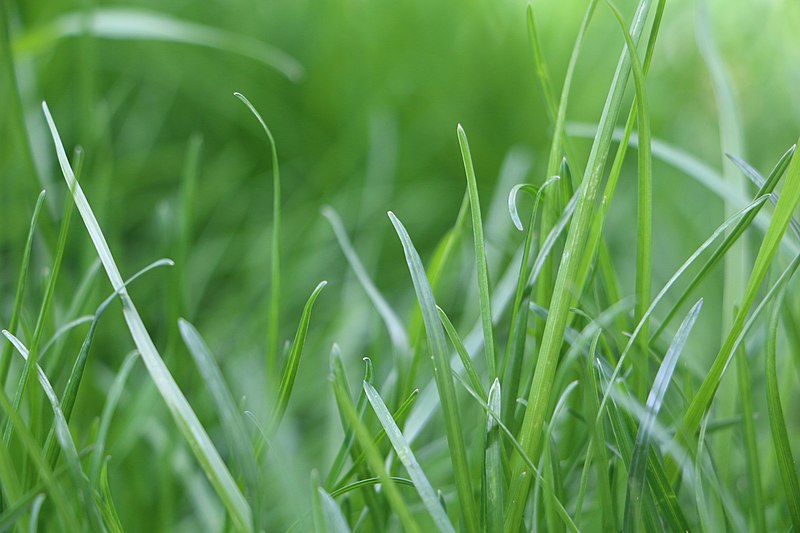
Photo Credit: Pilot138-17 / Wikimedia Commons / CC BY-SA 4.0
If you’d rather do the bulk of your lawn care in mild spring and fall, consider a cool-season grass like Kentucky bluegrass. It has a medium texture, dark green color, and dense growth pattern. The rhizomes can repair worn areas, allowing the grass to recover quickly from most damage. It prefers full sun but tolerates some shade.
Kentucky bluegrass isn’t the best choice if you want a green lawn in summer. It doesn’t handle hot temperatures well and is only moderately drought-tolerant. In the summer, it may need water as often as every one to three days. When stressed by heat, drought, or poor-quality soil, Kentucky bluegrass will be more susceptible to weeds and diseases. Mow high in summer to improve its performance.
Despite its slow growth in summer, Kentucky bluegrass can grow throughout fall, winter, and spring. It’s often mixed with perennial ryegrass (at least 15%) to improve its color and performance year-round.
Classification: Cool-season grass
Spreads by: Rhizomes
Shade tolerance: Low to moderate — prefers full sun
Drought tolerance: Moderate, but will survive by going dormant
Foot traffic tolerance: Low to moderate, but recuperates well
Maintenance needs: Moderate mowing frequency; a high-maintenance grass
Recommended mowing height: 2-3 inches
Potential for disease: Moderate to high; it’s susceptible to most diseases and insects.
Soil pH: 6-7
Soil type: Well-drained and fertile
Other notes: Produces a dense lawn under ideal conditions; many of these traits (shade tolerance, drought resistance, etc.) vary widely by cultivar, with newer cultivars generally being hardier, more resistant to disease, etc.; mow taller in summer; most often mixed with other species, such as perennial ryegrass, in home lawns
5. Perennial Ryegrass

Perennial Ryegrass
Photo Credit: Dr Mary Gillham Archive Project / Flickr / CC BY 2.0
Do you need traffic-tolerant cool-season grass? Rich green, fine-textured perennial ryegrass has the highest wear tolerance of all the cool-season grass types. Establish with seed or sod. It is frequently mixed with Kentucky bluegrass to improve traffic and disease tolerance.
Perennial ryegrass has a high cold tolerance, so you can expect it to stay green from February to June and October to December. This grass does exceptionally well in mild temperatures. Though it can tolerate a little shade, it prefers full sun. It doesn’t handle heat and drought well, so it may go dormant in summer.
Perennial ryegrass has a competitive growth pattern. Its fast emergence allows it to outcompete weeds. However, it also may outcompete other turfgrasses in mixed lawns, particularly warm-season varieties. If you overseed your warm-season lawn with perennial ryegrass, mow low and frequently to help encourage the warm-season grass to return.
Classification: Cool-season grass
Spreads by: Bunch-type grass
Shade tolerance: Low — prefers full sun
Drought tolerance: Low (may go dormant in summer)
Foot traffic tolerance: High, but poor recuperative ability
Maintenance needs: Moderate mowing requirement, depending on cutting height (lower cutting heights require more frequent mowing)
Recommended mowing height: 2-3 inches
Potential for disease: High
Soil pH: 6-7
Soil type: Fertile with good drainage
Other notes: Most often mixed with Kentucky bluegrass in a cool-season mix; well known for its excellent striping ability, low mowing tolerance (reel mower fans, this one’s for you), and rapid germination rate (four to seven days). It needs moderate levels of fertilizer.
6. Tall Fescue
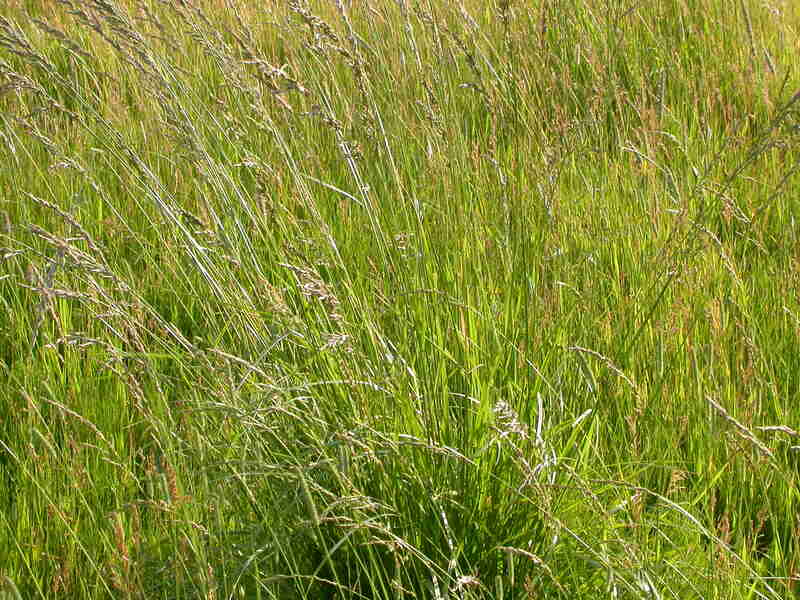
Photo Credit: Matt Lavin / Flickr / CC BY-SA 2.0
This medium to dark green grass is one of California’s most common lawn grasses. It does well in sunny or partially shady areas, with one of the best shade tolerances on this list. Tall fescue tolerates warm temperatures and cool winters well. It has good drought tolerance for cool-season grass and can handle moderate traffic.
Tall fescue is generally low-maintenance. It needs infrequent mowing and generally does well mowed high. If you mow too low, it could become thin and patchy.
Dense tall fescue lawns have a uniform, coarse-textured appearance, though some varieties have finer textures and shorter heights. This density helps the turf have good weed and disease resistance. However, its bunch-type growing pattern means it may develop thin patches. Reseed to fix these spots. You can establish tall fescue lawns with seed or sod.
Classification: Cool-season
Spreads by: Bunch-type grass
Shade tolerance: Moderate
Drought tolerance: Moderate
Foot traffic tolerance: Moderate, but low ability to recuperate from wear
Maintenance needs: Fast growth rate, so plan to mow more often
Recommended mowing height: 2-4 inches, depending on the cultivar
Potential for disease: Low to moderate under proper management conditions
Soil pH: 5.5-6.5
Soil type: Prefers fertile, well-drained soils but tolerates a broader range of soil conditions
Other notes: Reseed every few years to repair bare spots and thinning; don’t plant old varieties such as Kentucky-31; look for “turf-type” tall fescue (TTTF). Seed blends with more than one TTTF cultivar give the best chance for a strong lawn.
FAQ About the Best Grass Types for Sacramento
What is the best grass for California heat?
Whether your priority is drought resistance or a green lawn in summer, bermudagrass and UC Verde buffalograss are your best options. Buffalograss may turn brown during summer droughts, but it will still survive.
When should I plant grass in Sacramento?
Warm-season grasses do best when planted between mid-April and mid-May. You can plant cool-season grasses between March and April, but they also establish well in September and October. Spring is a good establishment time for all grass types, but the peak times vary by species. Here are the best times to plant each Sacramento grass type:
| Grass Type | Best Season to Plant |
| Bermudagrass | Late spring to early summer |
| Buffalograss | Late spring to early summer |
| St. Augustinegrass | Spring to early fall |
| Kentucky bluegrass | Fall or spring |
| Perennial ryegrass | Fall or spring |
| Tall fescue | Fall or spring |
When should I fertilize my lawn in Sacramento?
Like most lawn maintenance, it depends on whether it’s warm-season or cool-season. Grasses best utilize the nutrients in fertilizer when they’re actively growing. Using it too early or late could cause a growth spurt at the wrong time and make your grass more vulnerable to environmental factors like hot or cold weather. Here are the best months based on the grass type:
Warm-Season Grass: May, June, September, October
Cool-Season Grass: March, May, September, October
When to Hire a Pro
After you choose a grass type, you’ll need to plant and care for it. New grass needs frequent watering while establishing, which means more work for you. Reseeding an existing lawn may be simple enough for a weekend project. However, planting a brand new lawn or replacing an old one can be overwhelming, especially if you’re not experienced in lawn care.
Would you rather spend your spring at the Sacramento Baconfest? Let a local lawn care professional do the work for you. Their expertise will ensure your new lawn is established correctly so it’ll be in tip-top shape before you know it.
Main Image Credit: Barr House Sacramento / Ingawh / Wikimedia Commons / CC BY-SA 4.0